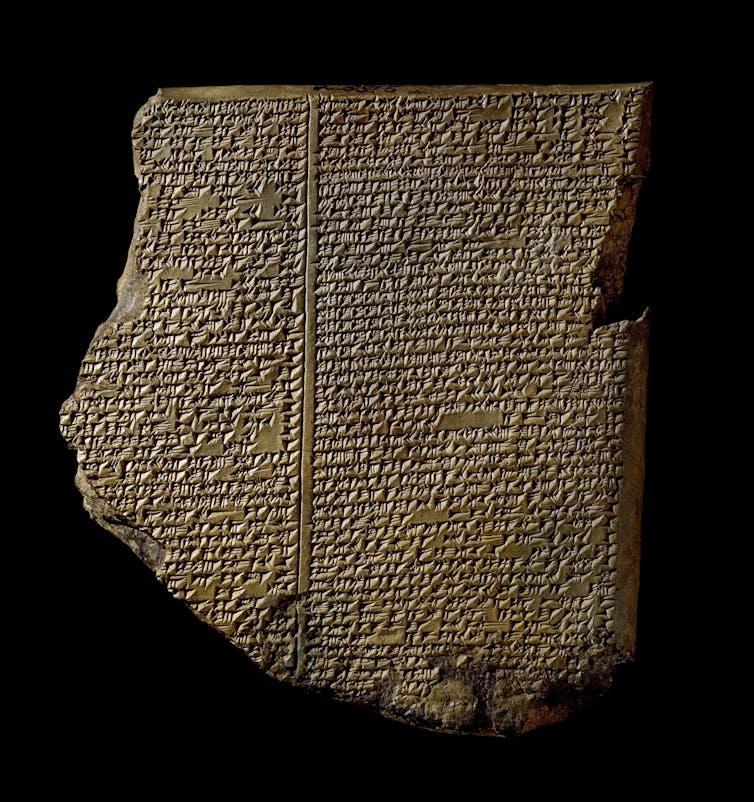
IMDB
Marvel’s Eternals will likely divide audiences into two groups: those who wish to tease out the mythical and comic book influences in Chloé Zhao’s modern epic, and those who prefer to enjoy the spectacle. This review takes the first approach, yet the film offers much to entertain both types of viewer.
From our partners:
Eternals explores new horizons in the Marvel Universe, both in its god-like protagonists, and in the inclusivity of its casting and plot-lines.
Shifting the franchise’s focus from mortals with extraordinary abilities and/or superpowers (such as Iron Man or Black Panther, the Eternals are new breed of Earth-defenders: a group of immortal (or at least, impressively enduring) superheroes often mistaken for deities.
But while they are new to the Marvel universe, they could more accurately be described as the (very) old guard.
An early origin story
Classical myths play a shaping role in many modern superhero stories, a trend that continues in Eternals.

J W Waterhouse/Art Gallery of South Australia
Thena (Angelina Jolie) is associated with the Greek goddess of warfare, Athena. Sersi (Gemma Chan) aligns with the enchantress from Homer’s Odyssey, Circe. Ikaris (Richard Madden) parallels the flying (and falling) Icarus from Cretan myth.
The first Eternals comic book was released in 1976. There, the Eternals and their enemies, the war-mongering Deviants, arrived from distant galaxies in ancient times and were viewed with awe by their puny Earthling relatives.
As the comic goes, the battles between Eternals and Deviants (continued in the film) were translated into the legends of numerous ancient cultures.
As per the self-mythology of the Eternals, it is not that these characters are inspired by Ancient Greek legends, but that Ancient Greek legends were inspired by them.
The first ancient Near Eastern Marvel superhero
The film opens with ten Eternals, clad in colourful cosmic activewear, establishing their role as planetary protectors in Mesopotamia around 7000 BCE.
Ancient Mesopotamia (roughly located in modern-day Iraq) was home to many early developments in civilisation, such as writing, agriculture, and even some of the earliest known literary “superheroes”: the legendary king Lugalbanda, for example, was divinely gifted with superspeed.
The character of Gilgamesh in Eternals is the first ancient Near Eastern hero with a leading role in a Marvel film.

In myth, Gilgamesh is the heroic protagonist of the world’s oldest known epic. The ancient story follows the journey of the heroic young king as he adventures to the edges of the world in search of fame and immortality.
Eternals gives further nods to Mesopotamian myth. There is speculation from fans that Kingo (Kumail Nanjiani) could represent the deity Kingu, from the Babylonian myth, Enuma Elish. In this myth, the primary deity Marduk battles the primordial ocean goddess, Tiamat.
Indeed, even Tiamat herself – or Tiamut in the film – counts among the heroes’ adversaries in Eternals.
A scene where the Eternals battle Deviants before the famous Ishtar Gate in ancient Babylon beautifully captures the largely untapped cinematic potential of the Mesopotamian world.

Read more: Behind The Scenes With ‘The Story Of Marvel Studios: The Making Of The Marvel Cinematic Universe’
A journey worth taking
The presence of a Mesopotamian legend and Korean superhero are just two of the “firsts” seen in Eternals. Others include the first openly gay superhero in the franchise (Phastos, played by Brian Tyree Henry), and a superhero who is hearing impaired (Lauren Ridloff’s Makkari).
The presence of same-sex relationships and characters with disabilities are common to many ancient myths and modern comics (Hawkeye of Avengers fame is portrayed with a hearing impairment in many comics). Here, Eternals’ Phastos is identified through his technical skills with Hephaestos, the Greek god of metalwork. In Classical myth, Hephaestos is depicted with a physical diability, walking with a limp.
Interestingly, metal work may have been a common occupation for people with physical disabilities in ancient Near Eastern culture — reflecting the interplay between history, myth, and popular culture common to the superhero genre.

Indeed, the film’s increased inclusivity brings it into closer alignment with both its ancient and modern sources.
For myth and comic book buffs, there is plenty to explore in Eternals. The film’s use of on-location shooting helps create a universe that feels broader and deeper than many before. The journey of Madden’s Ikaris reflects the typically creative recycling of ancient legends found in the comics.
Like speedy Makkari (whose character aligns with the messenger deity, Mercury known for his winged shoes), Ikaris’ power of flight is shared by his mythical counterpart Icarus – but it’s a power that must be used wisely.
Fans of the Gilgamesh epic will note his tendencies to take power naps and fight celestial bulls are adapted from ancient legend.
For those seeking pure entertainment, Eternals offers an inviting – at times spectacular – step into a world that is at once both old and new.
Eternals is in cinemas from today.![]()
Louise Pryke, Honorary Research Associate, University of Sydney
This article is republished from The Conversation under a Creative Commons license.
For enquiries, product placements, sponsorships, and collaborations, connect with us at [email protected]. We'd love to hear from you!
Our humans need coffee too! Your support is highly appreciated, thank you!

